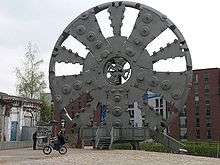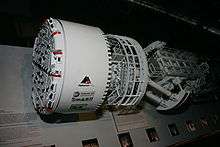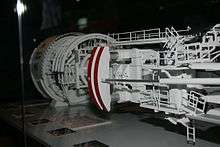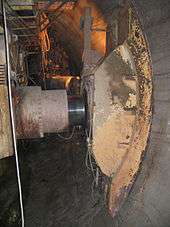Tunnel boring machine

.jpg)
A tunnel boring machine (TBM), also known as a "mole", is a machine used to excavate tunnels with a circular cross section through a variety of soil and rock strata. They may also be used for microtunneling. They can bore through anything from hard rock to sand. Tunnel diameters can range from a metre (done with micro-TBMs) to 19.25 metres to date. Tunnels of less than a metre or so in diameter are typically done using trenchless construction methods or horizontal directional drilling rather than TBMs.
Tunnel boring machines are used as an alternative to drilling and blasting (D&B) methods in rock and conventional "hand mining" in soil. TBMs have the advantages of limiting the disturbance to the surrounding ground and producing a smooth tunnel wall. This significantly reduces the cost of lining the tunnel, and makes them suitable to use in heavily urbanized areas. The major disadvantage is the upfront cost. TBMs are expensive to construct, and can be difficult to transport. However, as modern tunnels become longer, the cost of tunnel boring machines versus drill and blast is actually less. This is because tunneling with TBMs is much more efficient and results in shortened completion times (when they operate successfully).
Hitachi Zosen Corporation produced the world's largest-diameter TBM in 2013 – an earth pressure balance TBM known as Bertha with a bore diameter of 17.45 metres (57 ft 3 in).[1] It was delivered to Seattle, Washington, for its Highway 99 tunnel project.[2] The machine began operating in July 2013, but stalled in December 2013, and it has been able to operate normally for only for a few days since then.[3] After extensive repairs and multiple accidents, it was most recently shut down on January 14, 2016, citing concerns over public safety.[4]
Herrenknecht AG built the world's largest-diameter hard rock TBM. "Martina" (excavation diameter of 15.62 m, total length 130 m; excavation area of 192 square m, thrust value 39,485 t, total weight 4,500 tons, total installed capacity 18 MW; yearly energy consumption about 62,000,000 kWh) is owned and operated by the Italian construction company Toto S.p.A. Costruzioni Generali (Toto Group) for the Sparvo gallery of the Italian Motorway Pass A1 ("Variante di Valico A1"), near Florence.
The former largest-diameter hard rock TBM, which was also the largest-diameter TBM of any kind at the time, was a TBM with a bore diameter of 14.4 m that was manufactured by The Robbins Company for Canada's Niagara Tunnel Project. The machine was used to bore a hydroelectric tunnel beneath Niagara Falls. The machine was named "Big Becky" in reference to the Sir Adam Beck hydroelectric dams to which it is tunnelling to provide an additional hydroelectric tunnel.
History



The first successful tunnelling shield was developed by Sir Marc Isambard Brunel to excavate the Thames Tunnel in 1825. However, this was only the invention of the shield concept and did not involve the construction of a complete tunnel boring machine, the digging still having to be accomplished by the then standard excavation methods.[5]
The first boring machine reported to have been built was Henri-Joseph Maus's Mountain Slicer.[6][7][8][9][10] Commissioned by the King of Sardinia in 1845 to dig the Fréjus Rail Tunnel between France and Italy through the Alps, Maus had it built in 1846 in an arms factory near Turin. It consisted of more than 100 percussion drills mounted in the front of a locomotive-sized machine, mechanically power-driven from the entrance of the tunnel. The Revolutions of 1848 affected the funding, and the tunnel was not completed until 10 years later, by using less innovative and less expensive methods such as pneumatic drills.[11]
In the United States, the first boring machine to have been built was used in 1853 during the construction of the Hoosac Tunnel.[12] Made of cast iron, it was known as Wilson's Patented Stone-Cutting Machine, after inventor Charles Wilson.[13] It drilled 10 feet into the rock before breaking down. (The tunnel was eventually completed more than 20 years later, and as with the Fréjus Rail Tunnel, by using less ambitious methods.[14]) Wilson's machine anticipated modern TBMs in the sense that it employed cutting discs, like those of a disc harrow, which were attached to the rotating head of the machine.[15][16][17] In contrast to traditional chiseling or drilling and blasting, this innovative method of removing rock relied on simple metal wheels to apply a transient high pressure that fractured the rock.
Also in 1853, the American Ebenezer Talbot also patented a TBM that employed Wilson's cutting discs, although they were mounted on rotating arms, which in turn were mounted on a rotating plate.[18] In the 1870s, John D. Brunton of England built a machine employing cutting discs that were mounted eccentrically on rotating plates, which in turn were mounted eccentrically on a rotating plate, so that the cutting discs would travel over almost all of the rock face that was to be removed.[19][20]
The first TBM that tunneled a substantial distance was invented in 1863 and improved in 1875 by British Army officer Major Frederick Edward Blackett Beaumont (1833-1895); Beaumont's machine was further improved in 1880 by British Army officer Major Thomas English (1843-1935).[21][22][23][24][25] In 1875 the French National Assembly approved the construction of a tunnel under the English Channel and the British Parliament allowed a trial run to be made; English's TBM was chosen for the project. The cutting head of English's TBM consisted of a conical drill bit behind which were a pair of opposing arms on which were mounted cutting discs. From June 1882 to March 1883, the machine tunneled, through chalk, a total of 6,036 feet (1.84 km).[10] However, despite this success, the cross-Channel tunnel project was abandoned in 1883 after the British military raised fears that the tunnel might be used as an invasion route.[10][26] Nevertheless, in 1883, this TBM was used to bore a railway ventilation tunnel — 7 feet (2.1 m) in diameter and 6,750 feet (2 km) long — between Birkenhead and Liverpool, England, through sandstone under the Mersey River.[27]
During the late 19th and early 20th century, inventors continued to design, build, and test TBMs in response to the need for tunnels for railroads, subways, sewers, water supplies, etc. TBMs employing rotating arrays of drills or hammers were patented.[28] TBMs that resembled giant hole saws were proposed.[29] Other TBMs consisted of a rotating drum with metal tines on its outer surface,[30] or a rotating circular plate covered with teeth,[31] or revolving belts covered with metal teeth.[32] However, all of these TBMs proved expensive, cumbersome, and unable to excavate hard rock; interest in TBMs therefore declined. Nevertheless, TBM development continued in potash and coal mines, where the rock was softer.[33]
Description

Modern TBMs typically consist of the rotating cutting wheel, called a cutter head, followed by a main bearing, a thrust system and trailing support mechanisms. The type of machine used depends on the particular geology of the project, the amount of ground water present and other factors.
Hard rock TBMs

In hard rock, either shielded or open-type TBMs can be used. All types of hard rock TBMs excavate rock using disc cutters mounted in the cutter head. The disc cutters create compressive stress fractures in the rock, causing it to chip away from the rock in front of the machine, called the tunnel face. The excavated rock, known as muck, is transferred through openings in the cutter head to a belt conveyor, where it runs through the machine to a system of conveyors or muck cars for removal from the tunnel.
Open-type TBMs have no shield, leaving the area behind the cutter head open for rock support. To advance, the machine uses a gripper system that pushes against the side walls of the tunnel. Not all machines can be continuously steered while gripper shoes push on the side-walls, as in the case of a Wirth machine which will only steer while ungripped. The machine will then push forward off the grippers gaining thrust. At the end of a stroke, the rear legs of the machine are lowered, the grippers and propel cylinders are retracted. The retraction of the propel cylinders repositions the gripper assembly for the next boring cycle. The grippers are extended, the rear legs lifted, and boring begins again. The open-type, or Main Beam, TBM does not install concrete segments behind it as other machines do. Instead, the rock is held up using ground support methods such as ring beams, rock bolts, shotcrete, steel straps, ring steel and wire mesh.[34]
In fractured rock, shielded hard rock TBMs can be used, which erect concrete segments to support unstable tunnel walls behind the machine. Double Shield TBMs have two modes; in stable ground they can grip against the tunnel walls to advance. In unstable, fractured ground, the thrust is shifted to thrust cylinders that push off against the tunnel segments behind the machine. This keeps the significant thrust forces from impacting fragile tunnel walls. Single Shield TBMs operate in the same way, but are used only in fractured ground, as they can only push off against the concrete segments.[34]
Soft ground TBMs

In soft ground, there are three main types of TBMs: Earth Pressure Balance Machines (EPB), Slurry Shield (SS) and open-face type. Both types of closed machines operate like Single Shield TBMs, using thrust cylinders to advance forward by pushing off against concrete segments. Earth Pressure Balance Machines are used in soft ground with less than 7 bar of pressure. The cutter head does not use disc cutters only, but instead a combination of tungsten carbide cutting bits, carbide disc cutters, drag picks and/or hard rock disc cutters. The EPB gets its name because it is uses the excavated material to balance the pressure at the tunnel face. Pressure is maintained in the cutterhead by controlling the rate of extraction of spoil through the Archimedes screw and the advance rate. Additives such as bentonite, polymers and foam can be injected ahead of the face to increase the stability of the ground. Additives can also be injected in the cutterhead/extraction screw to ensure that the spoil remains sufficiently cohesive to form a plug in the Archimedes screw to maintain pressure in the cutterhead and restrict water flowing through.
In soft ground with very high water pressure or where ground conditions are granular (sands and gravels) so much so that a plug could not be formed in the Archimedes screw, Slurry Shield TBMs are needed. The cutterhead is filled with pressurised slurry which applies hydrostatic pressure to the excavation face. The slurry also acts as a transport medium by mixing with the excavated material before being pumped out of the cutterhead back to a slurry separation plant, usually outside of the tunnel. Slurry separation plants are a multi-stage filtration systems, which remove particles of spoil from the slurry so that it may be reused in the construction process. The limit to which slurry can be 'cleaned' depends on the particle size of the excavated material. For this reason, slurry TBMs are not suitable for silts and clays as the particle sizes of the spoil are less than that of the bentonite clay from which the slurry is made. In this case, the slurry is separated into water, which can be recycled and a clay cake, which is pressed from the water.
Open face TBMs in soft ground rely on the fact that the face of the ground being excavated will stand up with no support for a short period of time - this makes them suitable for use in rock types with a strength of up to 10MPa or so, and with low water inflows. Face sizes in excess of 10 metres can be excavated in this manner. The face is excavated using a backactor arm or cutter head to within 150mm of the edge of the shield. The shield is jacked forwards and cutters on the front of the shield cut the remaining ground to the same circular shape. Ground support is provided by use of precast concrete, or occasionally SGI (Spheroidal Graphite Iron), segments that are bolted or supported until a full ring of support has been erected. A final segment, called the key, is wedge-shaped, and expands the ring until it is tight against the circular cut of the ground left behind by cutters on the TBM shield. Many variations of this type of TBM exist.
While the use of TBMs relieves the need for large numbers of workers at high pressures, a caisson system is sometimes formed at the cutting head for slurry shield TBMs.[35][36] Workers entering this space for inspection, maintenance and repair need to be medically cleared as "fit to dive" and trained in the operation of the locks.[35][36]
Herrenknecht AG designed a 19.25 m (63 ft 2 in) soft ground TBM for the Orlovski Tunnel, a project in Saint Petersburg, but it was never built.
Back-up systems
Behind all types of tunnel boring machines, inside the finished part of the tunnel, are trailing support decks known as the back-up system. Support mechanisms located on the back-up can include: conveyors or other systems for muck removal, slurry pipelines if applicable, control rooms, electrical systems, dust removal, ventilation and mechanisms for transport of pre-cast segments.
Urban tunnelling and near surface tunnelling
Urban tunnelling has the special requirement that the ground surface be undisturbed. This means that ground subsidence must be avoided. The normal method of doing this in soft ground is to maintain the soil pressures during and after the tunnel construction. There is some difficulty in doing this, particularly in varied strata (e.g., boring through a region where the upper portion of the tunnel face is wet sand and the lower portion is hard rock).
TBMs with positive face control, such as EPB and SS, are used in such situations. Both types (EPB and SS) are capable of reducing the risk of surface subsidence and voids if operated properly and if the ground conditions are well documented.
When tunnelling in urban environments, other tunnels, existing utility lines and deep foundations need to be addressed in the early planning stages. The project must accommodate measures to mitigate any detrimental effects to other infrastructure. Subsidence is not the only problem when it comes to tunneling in an urban environment. Additional critical failure events such as face instability, collapse and large deformations of either or both excavation or its lining can lead to undesirable consequences such as injuries or loss of life, damage to third parties, additional costs, and delays in completion of the tunnel project. An exhaustive investigation carried out by Cardenas et al. reported the factors linked to the following events in tunnel works occurring during the construction phase:[37][38][39][40][41][42]
- Face instability in soft soils when using Slurry Shields,
- Face instability in soft soils when using an Earth Pressure Balance Shield,
- Collapse and large deformations in shaft excavations,
- Collapse and large deformations of excavations for cross passages in soft soils,
- Excessive volume loss leading to surface settlements in tunnels bored in soft soils,
- Excessive deformation, damage, and leakage of concrete lining.
The investigated factors cover issues related to design, boring process and ground conditions.
See also
- Boring
- New Austrian Tunnelling method
- Subterrene
- Tunnel
- Tunnelling shield
- Trenchless technology
- Channel Tunnel
- Roadheader
Notes
- ↑ Shield Tunneling Machines
- ↑ Alaskan Way Viaduct - Home
- ↑ Bertha the Giant Drill Is Ready to Rumble in Seattle
- ↑ Lindblom, Mike (January 14, 2016). "Inslee orders tunnel dig halted as soil sinks above Bertha". The Seattle Times. Retrieved January 14, 2016.
- ↑ Bagust 2006, p. 65.
- ↑ Drinker 1883, pp. 191-194.
- ↑ Bancroft 1908, p. 58.
- ↑ West 1988.
- ↑ Maidl et al. 2008.
- 1 2 3 Hemphill 2013.
- ↑ Hapgood, Fred, "The Underground Cutting Edge: The innovators who made digging tunnels high-tech",Invention & Technology Vol.20, #2, Fall 2004
- ↑ Maidl et al. 2008, p. 1.
- ↑ Smith, Gary. "FINDING AID FOR THE HOOSAC TUNNEL COLLECTION at the NORTH ADAMS PUBLIC LIBRARY". Hooac Tunnel Historical Notes. North Adams Public Library. Retrieved 14 July 2011.
- ↑ Howes, M. "Hoosac Tunnel History - Abridged Timeline". Retrieved 14 July 2011.
- ↑ Bancroft 1908, p. 65.
- ↑ Charles Wilson, "Dressing stone," U.S. Patent 5,012 (issued: March 13, 1847).
- ↑ Charles Wilson, "Machine for tunneling rocks, etc.," U.S. Patent 14,483 (issued: March 18, 1856).
- ↑ Ebenezer Talbot, "Machine for tunnelling or boring rock," U.S. Patent 9,774 (issued: June 7, 1853).
- ↑ West 1988, pp. 239-242.
- ↑ John D. Brunton, "Improved machine for sinking shafts," U.S. Patent 80,056 (issued: July 21, 1868).
- ↑ West 1988, pp. 243-247.
- ↑ David William Brunton and John Allen Davis, Modern Tunneling: With Special Reference to Mine and Water-supply Tunnels (New York, New York: John Wiley & Sons, 1914), p. 182.
- ↑ Frederick Edward Blackett Beaumont, U.K. Patent no. 1,904 (issued: July 30, 1864). (See: Patents for Inventions. Abridgments of Specifications relating to Mining, Quarrying, Tunnelling, and Well-sinking (London, England: Office of the Commissioners of Patents for Inventions, 1874), p. 247.)
- ↑ F.E.B. Beaumont, U.K. Patent no. 4,166 (issued: Dec. 2, 1875). (See: Patents for Inventions. Abridgments of Specifications. Class 85, Mining, Quarrying, Tunnelling, and Well-sinking (London, England: Patent Office, 1904), p. 169.)
- ↑ Thomas English, U.K. Patent no.s 4,347 (issued: October 25, 1880) and 5,317 (issued: December 5, 1881); "Tunneling-machine," U.S. Patent 307,278 (filed: June 4, 1884 ; issued: October 28, 1884).
- ↑ Terry Gourvish, The Official History of Britain and the Channel Tunnel (Abington, England: Routledge, 2006), Chapter 1, § 2: The commercial possibilities: Lord Richard Grosvenor, Sir Edward Watkin and the 'Manchester to Paris Railroad'.
- ↑ West 1988, p. 248.
- ↑ See:
- Bancroft 1908, pp. 66, 125, 127, 146
- Thales Lindsey, "Improved machine for tunneling rock," U.S. Patent 55,514 (issued: June 12, 1866).
- Pedro Unanue, "Tunneling machine," U.S. Patent 732,326 (filed: December 23, 1901; issued: June 30, 1903).
- Russell B. Sigafoos, "Rotary tunneling machine," U.S. Patent 901,392 (filed: May 18, 1907; issued: October 20, 1908).
- George A. Fowler, "Tunnel driving machine," U.S. Patent 891,473 (filed: July 30, 1907 ; issued: June 23, 1908).
- ↑ See:
- Bancroft 1908, pp. 66, 85, 106
- Charles Wilson, Machine for excavating tunnels," U.S. Patent 17,650 (issued: June 23, 1857).
- Reginald Stanley, U.K. Patent no. 1,449 (issued: February 1, 1886); "Tunneling-machine" (issued: August 7, 1894).
- Jonas L. Mitchell, "Tunneling-machine," U.S. Patent 537,899 (filed: April 3, 1893 ; issued: April 23, 1895).
- ↑ See:
- William F. Cooke and George Hunter, U.K. patent no. 433 (issued: August 10, 1866). Available online at: AditNow.
- Patents for Inventions. bridgments of Specifications relating to Mining, Quarrying, Tunnelling, and Well-sinking (London, England: Office of the Commissioners of Patents for Inventions, 1874), p. 275.
- Maidl et al. 2008
- ↑ See:
- Bancroft 1908, pp. 146, 165
- John P. Karns, "Tunneling-machine," U.S. Patent 848,107 (filed: November 29, 1905; issued: March 26, 1907).
- Olin S. Proctor, "Tunneling-machine," U.S. Patent 900,951 (filed: February 17, 1908; issued: October 13, 1908).
- ↑ See:
- Bancroft 1908, p. 145
- William A. Lathrop, "Machine for cutting headings," U.S. Patent 816,923 (filed: August 31, 1903; issued: April 3, 1906).
- ↑ For example:
- In Germany, the Eisener Bergmann (iron miner) was developed in 1916 by Schmidt, Kranz & Co. for potash mines; its boring head consisted of a large rotating roller that was fitted with cutters See: Maidl et al. 2008
- In the U.S., the McKinlay Entry Driver, a track-mounted TBM or "continuous miner", was invented in 1918 for use in coal mines. Its boring head consisted of metal tines on two, side-by-side rotating arms. See: Thomas W. Garges (November 13, 2003) William N. Poundstone lecture: "Underground Mining Technology Evolution", p. 8. Available online at: http://www2.cemr.wvu.edu/~wwwmine/poundstonelec/GargesThomastxt.pdf Benjamin M. Statler College of Engineering and Mineral Resources, West Virginia University]
- 1 2 Stack 1995.
- 1 2 Walters, D. "Sydney Airport Link Rail Tunnel Project, Des Walters: Under Pressure Underground". Descend Underwater Training Centre. Retrieved 2008-10-08.
- 1 2 Bennett, MH; Lehm, J; Barr, P. "Medical support for the Sydney Airport Link Tunnel project". Journal of the South Pacific Underwater Medicine Society 32 (2). Retrieved 2008-10-08.
- ↑ Cardenas, IC; Al-Jibouri, SHS; Halman, JIM; van de Linde, W; Kaalberg, F (2013). "Relevant risk factors associated with the construction of excavated tunnel cross-passages in soft soils". Geotechniek 17 (1).
- ↑ Cárdenas, IC; Al-Jibouri, SHS; Halman, JIM; van Tol, FA (2013). "Capturing and Integrating Knowledge for Managing Risks in Tunnel Works". Risk Analysis 33 (1): 92–108. doi:10.1111/j.1539-6924.2012.01829.x.
- ↑ Cardenas, IC; Al-Jibouri, SHS; Halman, JIM; van Tol, FA (2014). "Modeling Risk-Related Knowledge in Tunneling Projects". Risk Analysis 34 (2): 323–339. doi:10.1111/risa.12094.
- ↑ Cardenas, IC; Al-Jibouri, SHS; Halman, JIM; van de Linde, W; Kaalberg, F (2014). "Using Prior Risk-Related Knowledge to Support Risk Management Decisions: Lessons Learnt from a Tunneling Project". Risk Analysis 34 (8). doi:10.1111/risa.12213.
- ↑ Cardenas, IC (2015). "Modeling the Influence of Unknown Factors in Risk Analysis Using Bayesian Networks". Under review by a refereed journal.
- ↑ Cardenas, IC (2012). "Integrating knowledge for managing risk in infrastructure projects : the case of tunnel works". PhD Thesis. University of Twente.
References
- Bagust, Harold (2006). The greater genius?: a biography of Marc Isambard Brunel. Ian Allan Publishing. ISBN 0-7110-3175-4.
- George J. Bancroft (1908) "A history of the tunnel boring machine," Mining Science, p. 58, 65-68, 85-88, 106-108, 125-127, 145-146, 165-167
- Barton, Nick. 'TBM tunnelling in jointed and faulted rock'. Balkema, Rotterdam, 2000.
- Bilger, Burkhard, "The Long Dig: Getting through the Swiss Alps the hard way", The New Yorker, September 15, 2008.
- Henry Sturgis Drinker, Treatise on Explosive Compounds, Machine Rock Drills and Blasting (New York, New York: J. Wiley & Sons, 1883), pp. 191-194.
- Foley, Amanda, "Life on the Cutting Edge: Dick Robbins", "Tunnels & Tunnelling International", May 2009.
- Gary B. Hemphill, Practical Tunnel Construction (Hoboken, New Jersey: John Wiley & Sons, 2013), Chapter 7: Tunnel-boring machines: History of tunnel-boring machine.
- Bernhard Maidl, Leonhard Schmid, Willy Ritz, Martin Herrenknecht (2008). Hardrock Tunnel Boring Machines. Ernst & Sohn. ISBN 978-3-433-01676-3.
- Stack, Barbara, "Encyclopaedia of Tunnelling, Mining, and Drilling Equipment", 1995.
- Graham West, Innovation and the Rise of the Tunnelling Industry (Cambridge, England: Cambridge University Press, 1988), Chapter 11: Hard rock tunnelling machines.
External links
| Wikimedia Commons has media related to: |
- 2.M-30 EPB Tunnel Boring Machine - the largest built in the world
- Video on how a Tunnel Boring Machine works
- Herrenknecht TBM Animation